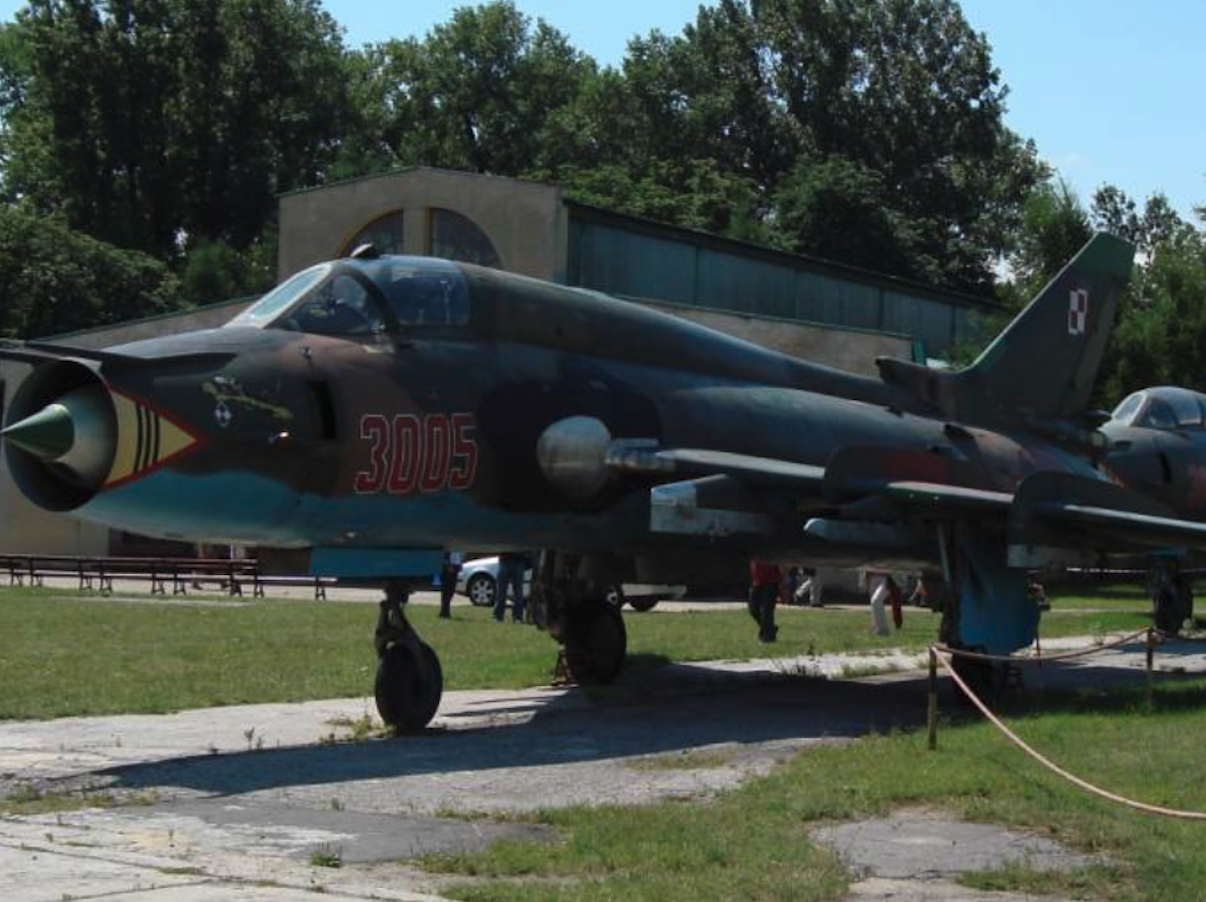Kraków 2007-09-01
269 Section 1984-05-05
OKB Suchoj Su-22 M 4 K, Su-22 UM 3 K. Poland.
Supersonic fighter-bomber with variable wing geometry.
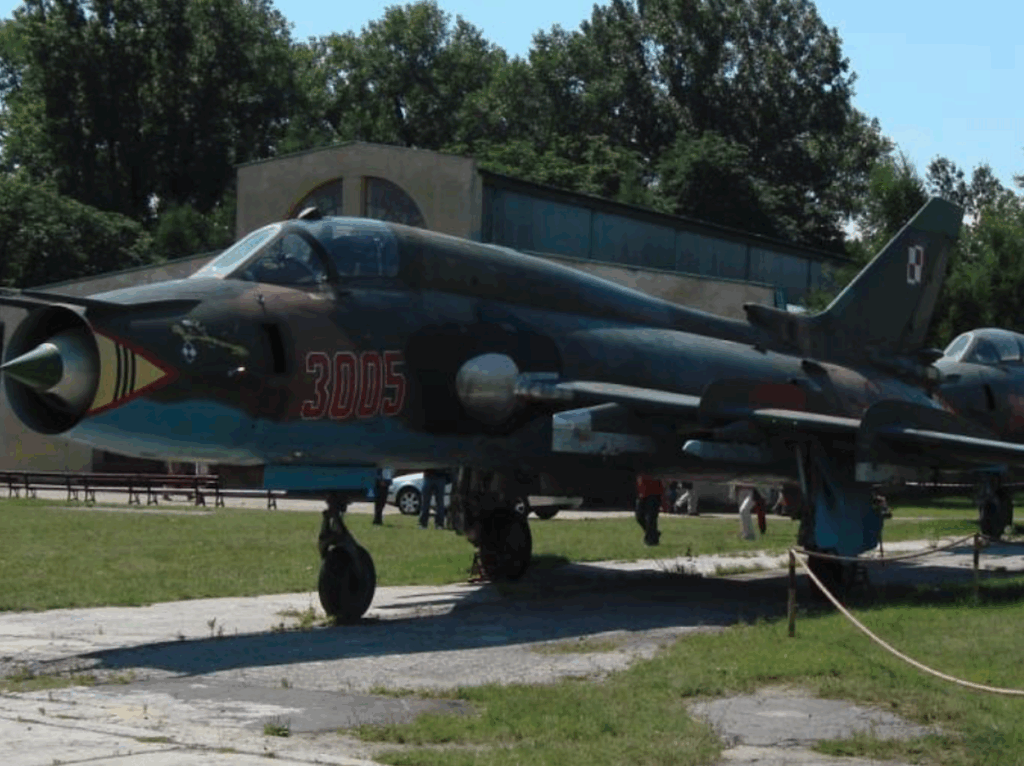
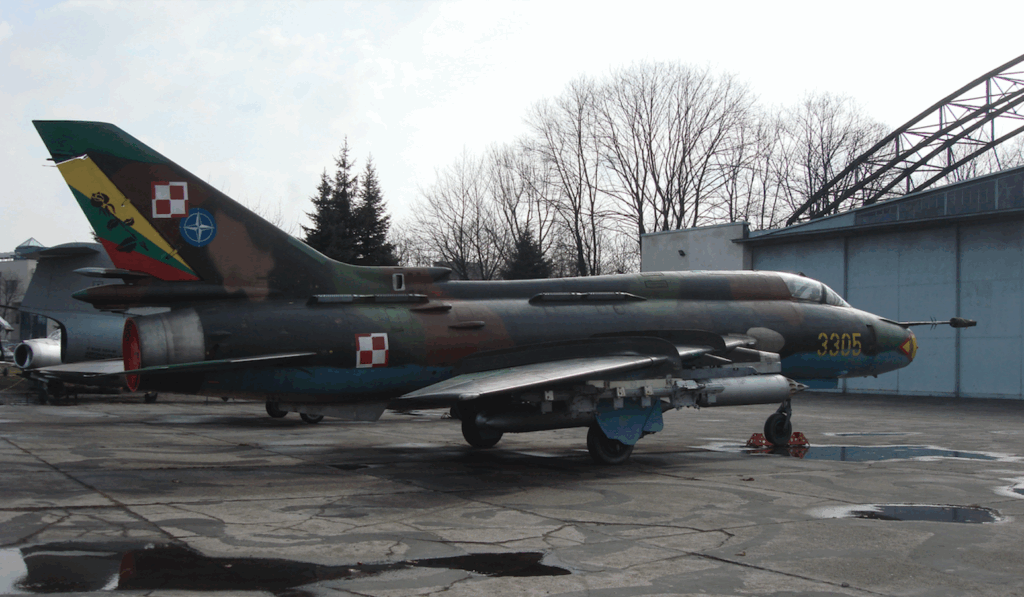
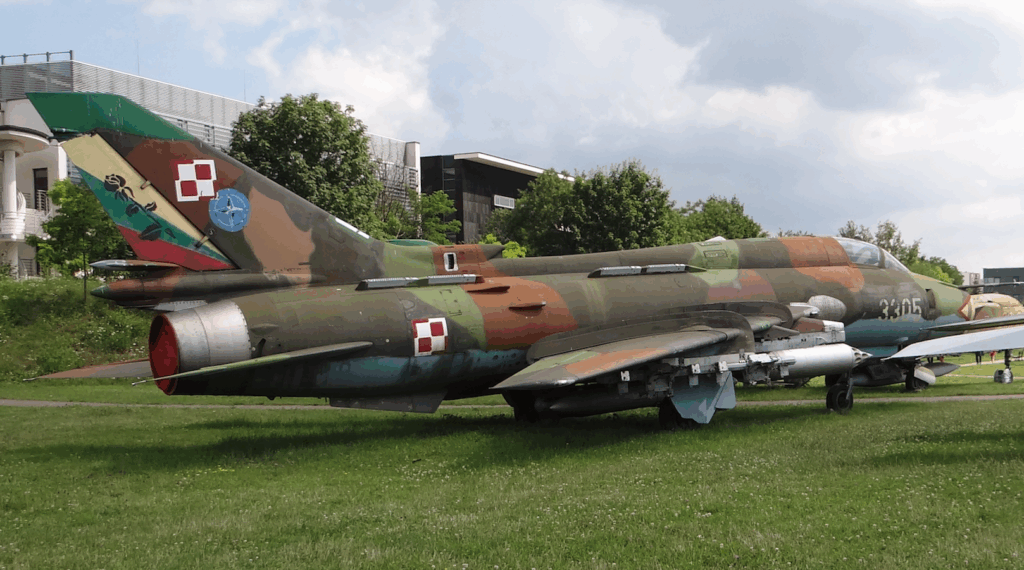
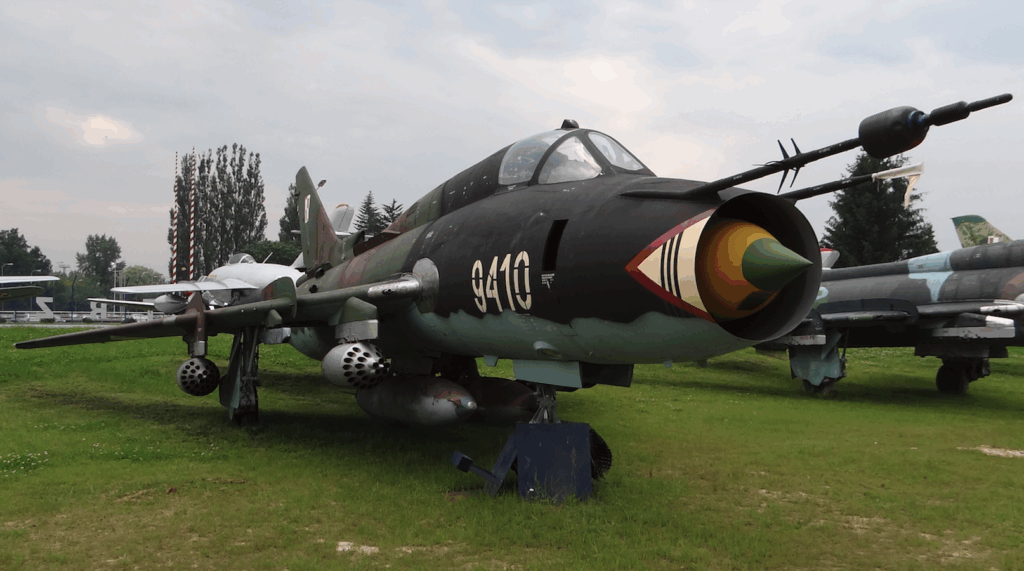
History of the aircraft.
In the CCCP, the Su-17 aircraft, despite constant modifications and the creation of the second generation, still did not meet the assumptions placed on it. It was not about flight properties and performance, but about the ability to effectively attack ground targets in “all weather conditions”. Variable wing geometry was not a sufficient argument here. The key to success was new equipment based on modern electronics, and Moscow was starting to lack it. And the idea of building highly specialized aircraft did not help here.
In the Su-17 M 2 fighter-bomber, great emphasis was placed on installing target electronics and weapons. The pilot’s working conditions were also improved by slightly widening the cabin. However, the front of the fuselage still limited visibility. Additionally, there was no training and combat aircraft on which new pilots could be safely trained. The Su-7 U no longer fulfilled its role. Therefore, back in October 1974, the Soviet authorities (the Central Committee of the CPSU and the Council of Ministers of the CCCP) ordered the Sukhoi OKB to build two new versions of the Su-17; the S-52 – with improved visibility and aiming conditions and electronics unified with the MiG-27M aircraft. The S-52 U – a training and combat aircraft with priority implementation.
Su-17 version S-52. 1976.
The front part of the fuselage underwent significant reconstruction. The idea was to accommodate new equipment and significantly improve the pilot’s working conditions. The front part of the fuselage was shortened, the air intake was slightly lowered, and the rest was significantly thickened. This was achieved by tilting the fuselage axis by 3 degrees, counting from the 13th frame forward. Now the visibility from the cockpit became comparable to the visibility from aircraft without frontal air intakes. The superstructure was expanded behind the cockpit. To improve directional stability, the vertical tail was raised, adding an additional element, and an inflow was built. Later, a small aerodynamic guide was added under the fuselage.
The cockpit itself was significantly enlarged, the seat was raised upwards, which improved the pilot’s working conditions. In this way, the forward viewing angle was increased, downwards from 9 degrees to 15 degrees. Pilot safety was increased by the use of the K-36 D series 2 ejection seat, class 0-75, and a little later class 0-0.
The number of armament nodes was increased to 10 pieces, although there are “national” versions with 8 nodes. This additional pair of nodes appeared under the wings and is used exclusively to carry defensive armament consisting of guided missiles of the R-60, R-55 or R-13 anti-aircraft class. The DISS-7 automatic navigation system, for avoiding terrain obstacles, was now placed inside the fuselage, and not as previously in the fairing below it. All these changes resulted in the creation of an easily recognizable “humpback” silhouette of the aircraft. In order to maintain the possibility of operating from ground airports, a reinforced landing gear and new wheels were introduced. The new fuselage line also allowed for an increase in fuel capacity by 100 kg. The aircraft’s armor was improved, the weight of which increased from 165 kg to 195 kg. The armament load was increased to 4,250 kg. The aircraft’s take-off weight increased by 400 kg. Considerable changes were made to the equipment. The modified SAU-22 M 1 system allows, for the first time, automatic flight at supersonic speed at an altitude of 200 m. Installed: RW-15 radio altimeter, SRO-1 P and SO-69 devices.
The first prototype of the S-52 was an aerodynamic demonstrator, because the proper electronics were not yet available. The first flight of the S-52 aircraft took place in the first half of 1976. Probably on April 4, 1976. The second prototype, intended for state tests, joined in January 1977. The aircraft already had a Klen-PS laser station built into the front of the fuselage, which took over the functions performed until then by the Fon-1400 laser rangefinder and the Prożektor-1 target illumination station. The Klen-PS station allowed for measuring distances up to 10,000 m, and illumination at a distance of 7,000 m. Importantly, the laser beam could be deflected in the horizontal plane by +-12 degrees, and in the vertical plane by +6 degrees, -30 degrees, which allowed for some freedom in maneuvering and even an attack from horizontal flight. The ASP-17 and PBK-3-17 S sights were integrated into a single electronic complex. Now the complex has been named ASP-17 B. The first phase of state trials was completed in the second half of 1977, however, many comments and conclusions were formulated for rapid implementation. The electronic systems were highly unreliable and did not work well together. There were problems with the current assessment of the aircraft’s movement parameters in relation to the target. The sight’s calculator (processor, computer) also did not keep up.
Production of the Su-17 M 3 (Su-19) aircraft.
During this time, the third prototype and two more were built. All five prototypes took part in the second phase of state trials, in March-December 1978. According to unconfirmed data, in the autumn of 1977, the second prototype S-52-2 was lost. In December 1978, the aircraft was conditionally recommended for production, since the trials were not entirely satisfactory. The aircraft was to receive the designation Su-19. This happened at the time of a major scandal at high levels, as the factory in Komsomolsk-on-Amur had several dozen Su-17 M 3 aircraft that had been manufactured but not accepted by the military. Ultimately, the Ministry of Aviation forced the military to take over the aircraft conditionally, and the new designation Su-19 did not catch on, and the newly manufactured aircraft were given the designation Su-17 M 3. It is possible that the military demanded a much more modern design.
Ultimately, it turned out that the Su-17 M 3 was the most widely produced version of this aircraft. 488 units were built from late 1976 to 1981. Due to the long production period and emerging problems, serial production is distinguished by three stages; In the first, the S-52 model, the airframe was distinguished by new shapes and technological changes. Generally, however, the avionics came from the Su-17 M 2. In the second stage, the S-52 M model is distinguished by a higher tip of the vertical stabilizer and a sub-fuselage aerodynamic guide. This was the result of the revealed lack of directional stability at high angles of attack and with the wing set to the maximum sweep. Gradually, in 1979-1980, the repair plants brought the previous aircraft to the S-52 M standard. Only the third stage of production, 1978-1979, led to the aircraft being in the S-52 M 3 standard with target avionics and weapons. This was the 38th production series.
The Su-17 M 3 aircraft received WRE means consisting of the SPS-141 MWG Gvozdika active jamming station in the pod. This station not only indicated the direction of radiation, but using the data library, was able to indicate the type of station and the type of danger. It was supplemented by the KDS-23 dipole and thermal flare launcher, placed on the fuselage.
In 1981, from the 54th production series, the Su-17 M 3 P machines were assembled. They are adapted to carry new Kh-27 and Kh-58 anti-radiation missiles. Target search and indication is carried out by the Vjuga-17 device, placed in a pod under the fuselage in front of the aerodynamic guide. The aircraft was also armed with Kh-29 Ł missiles, laser-guided. They can be fired similarly to Kh-58 missiles from the symmetrical, twin AKU-58 launcher, placed under the fuselage. APU-68 UM 3 rail launchers were also introduced for missiles such as; S-24, Kh-23, Kh-25 (modular). The fire control system included a BSPPU block allowing firing from the SPPU-22-01 gondola in the “automatic target tracking” mode, with a barrel depression angle of -30 degrees forward or backward. It was not until July 1981 that the Su-17 M 3 aircraft were officially accepted into service.
Su-17 UM 3 (S-52 U). 1975
Based on the S-52 aircraft, the training and combat version of the S-52 U (S-53) was built. The pilots’ seats were arranged in tandem. A centralized ejection system with K-36 D S 2 seats was introduced. The instructor’s cabin was equipped with a periscope system. Space for the second cabin was created by reducing fuel tank no. 1. Overall, the fuel capacity decreased to 3,050 kg. The equipment was modified by introducing the SAU-22 MU control system. The SPU-9 on-board intercom and MS-61 tape recorder were added. The left cannon was dismantled, but the weight of the aircraft increased to 10,900 kg. The armament capacity decreased to 3,000 kg, which is why the second pair of under-fuselage armament mounts was abandoned.
In September 1975, the first prototype of the S-52 U was flown by pilot V. A. Krechetov. The first prototype was soon joined by a second one. During state trials in 1976, the S-52 U was recommended for serial production under the designation Su-17 U. The trials were completed in May 1977. From 1978, the Su-17 UM (S-52 UW) was built with a raised vertical stabilizer and an aerodynamic guide under the fuselage. In the period 1979-1980, all aircraft were brought to the latest standard.
At the end of July 1978, a decision was made to build a training and combat aircraft with avionics unified with the Su-17 M 3. In October 1978, the S-52 UM 3 prototype was flown, but its tests lasted as long as two years and the aircraft entered state trials in May 1981. Its serial production was already underway in 1978-1979 and ended with 165 aircraft. Importantly, all 75 units of previously produced Su-17 UM aircraft were brought to the Su-17 UM 3 standard in 1981-1983. In total, 240 Su-17 UM 3 machines were produced.
Su-22 M i Su-22 M 3. 1977
In February 1977, the prototype S-52 K, an export version of the Su-22 M, was flown. This aircraft and the first production model were used for state trials from June 1978 to February 1979. In 1977, aircraft under the designation Su-22 M, with R-29 BS engines were purchased by Peru, and then by Libya, Angola and others. Between 1979 and 1984, 272 Su-22 Ms were produced for Afghanistan, Algeria, Iraq, Yemen, Libya, Peru, Syria and Vietnam.
The Su-22 M was a variant of the early production Su-17 M 3 with a Fon-1400 laser rangefinder. It was powered by the R-29 BS-300 engine. It was therefore a combination of the front fuselage of the early Su-17 M 3 with the rear of the Su-22. In production, the aircraft received a higher tail and (although not always) a sub-fuselage aerodynamic guide. The most loyal allies received Kh-23 and Kh-28 missiles for the aircraft.
In the period 1981-1983, Su-22 M 3 aircraft were produced with the equipment of late-series Su-17 M 3 and R-29 BS-300 engines. 59 aircraft were built and sent to Afghanistan, Iraq and Hungary. Su-22 M-3 were delivered to Hungary in the number of 10 units and training-combat Su-22 UM-3 in the number of 3 units and were stationed at the Kecskemet base (1990). Users of both versions were offered KKR-1 reconnaissance pods. They were certainly purchased by Hungary (Su-22 M 3 R) and Vietnam (Su-22 MR).
Su-22 U, Su-22 UM, Su-22 UM 3. 1976
The Su-22, Su-22 M and Su-22 M 3 training and combat aircraft with the R-29 BS-300 engine were designated Su-22, Su-22 UM and Su-22 UM 3, respectively. The Su-22 U prototype was a conversion of one of the first Su-17 U. It was built in October 1976 and first flown in December 1976 by Ye. S. Soloviev. In April 1977, factory tests were completed and the aircraft was sent for state tests. They lasted from September 1977 to March 1978, and then the aircraft was sent for serial production. The Su-22 UM prototype first flew in December 1979. Production was carried out in the period 1979-1984, when 45 aircraft were built. In the period 1982-1983, 9 Su-22 UM 3 machines were produced.
Su-17 M 4 (S-54). 1978
The long-term and not fully overcome difficulties with the integration of the avionics and armament of the Su-17 M 3 aircraft meant that in March 1977, the Sukhoi OKB was tasked with building another version of the aircraft equipped, this time with the integrated PRNK-54 Zarya targeting and navigation system. The program in the bureau was designated S-54. Three copies of the serial Su-17 M 3 aircraft were rebuilt into prototypes of the new version. The first prototype flew in 1978. The pilot was A. Isakov. State tests of the aircraft, now designated Su-17 M 4, were carried out from 1980 to November 1982. The aircraft was officially accepted for service in September 1983, although production had been underway since 1980 and ended in 1988. The production plant was, of course, Komsomolsk-on-Amur. 231 units were built.
The heart of the aircraft was the integrated PRNK-54 complex (price-navigation complex) with the Orbita-20-22 on-board computer, which simplified the pilot’s work. In the Su-17 M 3, the integration was carried out by the pilot. The accuracy of navigation and attack increased dramatically. Surface objects with known coordinates can now be attacked in “any weather conditions”, day and night. A small air intake on the inflow of the vertical tail is a visible element of the use of this equipment. It serves to cool the electronics. Before the flight, the coordinates of the target and turning points on the route are entered into the computer. The aircraft can be guided automatically or manually by the pilot. In the last section of the route, the flight route is corrected using the RSDN-10 long-range navigation system (radiotechnicheskaya system for long-range navigation). This correction was missing in the KN-23 system on the Su-17 M 3 aircraft. Then the computer itself guides the aircraft to the target line and launches the warheads without the need for visual contact with the target. The system allows for an attack in “all weather conditions”. However, it has two weak points; before the flight, the target’s coordinates must be known precisely, and the RSDN-10 system is sensitive to jamming.
Used; RSBN-7 S (RSBN-6 S) short-range navigation system, RSDN-10 long-range navigation radio system (for the first time), R-862 radio station. IKW inertial course and vertical system, SAU-23 B automatic control system, DISS-7 Doppler speed and drift angle meter. Other devices ARK-15 M or newer ARK-22, RW-4 or newer RW-21, SRO-2, SPO-10, Klen-54, MRP-66. The weapon system includes ASP-17 B or newer optical fighter-bomber sight, bomber, Fon laser rangefinder.
Kh-29 T missiles, controlled by TV using IT-23 M monitor, were introduced into the armament. In addition, the central cone was blocked on the Su-17 M 4, removing the ASUW-1 W control system from it. Fuel capacity was reduced. In total, the machine’s empty weight decreased by 300 kg, which allowed for improving some flight parameters. As a result of Afghan experience, from 1984, the number of ASO-2 W launchers with flares was increased on the Su-17 M 4 (4/8/12). From 1987, an improved ASO-2 WM model was introduced, the armor of the bottom of the fuselage was improved and several other minor changes were made. Identical changes were made to the Su-17 M 3 aircraft, on which the important RSDN-10 long-range navigation system was additionally installed.
Su-22 M 4, Su-22 UM 3 K. 1983
In 1983, a decision was made to export the latest versions of the Su-17 M 4 and Su-17 UM 3. They were designated Su-22 M 4 (S-54 K) and Su-22 UM 3 K (S-52 M 3 K), respectively. They were equipped with AL.-21 F-3 engines, minor changes in electronics, and in armament, apart from TV-guided missiles, the entire remaining range. In total, by 1990, 166 Su-22 M 4 machines and 41 Su-22 UM 3 K aircraft were produced. But these numbers seem unreliable, because, for example, Czechoslovakia and Poland received 186 Su-22 M 4 and 36 Su-22 UM 3 K. And what about other users? Unless they received refurbished Su-17 M 4, as Su-22 M 4. According to approximate data, about 347 Su-22 M 4 and 60 Su-22 UM 3 were actually exported. It is also estimated that the total production of Su-17 family aircraft amounted to 2,864, while the manufacturer states 2,522 units. The first foreign users since 1984 were; Poland, Czechoslovakia and the GDR. Later, Afghanistan also received them, from where one went to Pakistan in unknown circumstances.
Su-17 M 3 R, Su-17 M 4 R, Su-22 M 3 R, Su-22 M 4 R.
Some of the aircraft used in the CCCP were adapted for reconnaissance tasks. In addition to the standard KKR-1 pod, they could also carry modified KKR-1 T pods, in which the SRS-9 general electronic reconnaissance station was replaced with the SRS-13 Tangazh. A modular KKR-1/2 (KKR-2) pod was also developed. AFA-39 and AP-402 cameras for perspective and panoramic photography were a permanent element. On the other hand, modules with a Czibis or Aist television camera and real-time image transmission; a Zima thermal imager and a Tangazh station – were interchangeable. The KKR-2 pod was not exported. Some units of the export versions were also adapted to carry KKR-1, KKR-1 T pods; for example the Hungarian Su-22 M 3 and the Polish Su-22 M 4.
The subsequent versions of the Su-22 differ in the equipment used. There are about 10 derivative versions, although there are three basic ones. It is difficult to classify them precisely, because the aircraft was mainly produced for export. Besides, this is not the most important thing, because the biggest differences are inside in the electronic equipment; navigation, targeting, warning and Radio-Electronic Wail.
Why is the Su-22 the way it is? (Analysis conducted in 1985).
A fighter-bomber in Europe is defined by three features; Autonomy, survivability and power, and striking effectiveness.
Autonomy is the ability to operate independently. A typical Su-22 task is to attack selected targets deep in enemy territory. The aircraft therefore flies long distances at low altitude. As a result, it leaves the close navigation zone and loses radio contact with the base. Flying command posts do not work in European conditions, because they can only operate with complete control of the air or far above their own territory. The Su-22 pilot must find and recognize the target on his own. The aid comes from radar and laser devices. The navigation and targeting system is combined into a single navigation and targeting device. Navigation is based on an inertial, gyroscopic system. The pilot has constant information about the position. The computer solves navigation and piloting problems according to a previously programmed flight path to the target and back to the base. A close navigation system operates near the base. The automatic control system relieves the pilot, allowing him to focus on completing the task. In the event of loss of orientation in space, all the pilot has to do is press a button on the control stick, and the aircraft will automatically be brought to a horizontal position, without fear of collision with the ground. Indicators and signaling inform about technical failures before they become dangerous. The most important data is displayed on a translucent indicator on the windshield.
Survival is the life of the structure. That is why the fuel tanks were armored. The hydraulic system was doubled. Survival is warning about radiation, launching anti-aircraft missiles and Radio-Electronic Warfare (WRe). The aircraft is automatically able to perform an anti-missile maneuver with parameters determined by the computer. In the event of being entangled in a maneuver fight, the pilot can use the barrel armament and two infrared C.P.R.s. The aircraft received an active and passive WRe system in the form of the SPS-141 station, enabling the use of active jamming in the aircraft’s front hemisphere and the launch of dipoles and thermal traps.
The effectiveness of destruction is the ability to perform the assigned task. The aircraft has a class p-z c.p.r. with a range of 10-20 km. Laser or anti-radiation guidance system. (The predecessor, the Su-20 aircraft, did not have a class p-z c.p.r.). Guided or classic bombs of various weights can also be used.
Significant progress has also been made in aircraft maintenance compared to previous versions. The number of personnel has been reduced. The time and number of inspections have been shortened. All thanks to modern diagnostics. The qualitative leap between the Su-22 and the Su-20 is the same as between the Su-20 and the Su-7 B.
History of the purchase of Su-22 M 4 K and Su-22 UM 3 K aircraft for the Polish Army.
The outbreak of the Second Cold War, in the early 1980s, forced the Warsaw Pact countries to rearm. In Poland, a limited number of MiG-23 MF aircraft and, for financial reasons, MiG-21 bis were introduced into the fighter aviation.
However, the real rearmament took place in the fighter-bomber (attack) aviation. Both in terms of quality and quantity. We purchased Su-22 aircraft in two versions; single-seat Su-22 M 4 K and two-seat Su-22 M 3 K. In 1985, we received the first 20 and 6 units, respectively. In total, we bought 90 single-seat aircraft and 20 two-seat aircraft, which together gave 110 units, or equipment for three air regiments and one squadron.
The Su-22 M 3 competed with the MiG-23 BN for deliveries to Poland. In 1982, for economic reasons, the Sukhoi aircraft was selected. However, the decision to purchase was not made. In 1983, the Soviets proposed the purchase of a newer version of the aircraft, specifically the Su-22 M 4, and then an order was placed for 80 Su-22 M 4 and 20 Su-22 UM 3 K for two fighter-bomber regiments and two squadrons of the 7th BLR-B (Bomber-Reconnaissance Aviation Brigade). In 1986, 20 more Su-22 M 4 aircraft were ordered to equip the third regiment (8th PLM-B from Mirosławiec) with this type of aircraft instead of two squadrons of the 7th BLBR (which remained equipped with Su-20 aircraft).
In the period August-October 1984, the first 13 aircraft arrived at Powidz on board Il-76 and An-12/22. These were 7 Su-22 M 4 machines (nb 3005, 3212, 3213, 3908-3911) and 6 combat-training Su-22 UM 3 K (104, 305-308, 509). All of them became part of the 6th PLM-B (fighter-bomber aviation regiment) in Piła, in August 1985, the 40th PLM-B from Świdwin received its first Su-22, and in May 1986, the third squadron of the 7th PLB-R (bomber-reconnaissance aviation regiment) from Powidz (initially this squadron was to be part of the 8th PLM-B in Mirosławiec).
In May 1985, the first group of pilots went to Krasnodar for training on the new equipment. They returned in July 1985.
Deliveries of Su-22s were carried out differently than 10 years earlier with Su-20s, which simply flew in. Su-22s were delivered to Powidz in crates. Here, the Soviets assembled and flew the equipment themselves. Only then did they hand it over to the Polish side. The Soviets probably flew the first Polish Su-22 M 4 in Powidz on 1984-05-05. The technical life of Polish Su-22s in peacetime is 20-25 years.
Some of the first pilots were; Lt. Col. pilot Bogdan Likus, Jan Kania and Zenon Jankowski (the Polish cosmonaut’s understudy).
The first unit equipped with the new aircraft was the 7th PLMB from Powidz. The next were the 6th PLMB in Piła and the 8th PLMB in Mirosławiec. Each unit received 36 aircraft for 3 squadrons (in accordance with the then staff).
The first period of use of the new aircraft fell on the second half of the 80s. Polish pilots mastered piloting relatively quickly and performed take-offs and landings at DOL in the first years of operation. Combat training was conducted at the Nadarzyce training ground and at the naval training ground near Ustka. Of particular importance was training using new, previously unused in the Polish Army, guided weapons of the p-z class (air-to-ground, air-to-water, and according to the changed nomenclature air-to-surface). Since the Polish state was firmly embedded in the Warsaw Pact, the tasks assigned to the new machines remained unchanged.
As of 1991-01-01, there were 85 Su-22 M 4 K and 19 Su-22 UM 3 K in service. We lost 2 pilots and 3 Su-22 M 4 K and 1 Su-22 UM 3 K.
The socio-political changes in Poland that began in 1989 resulted in Poland’s pressure to join the North Atlantic Alliance (NATO), which finally happened in 1999. However, since the early 1990s, Poland has been seeking its subjectivity in new conditions. This was manifested, among other things, in establishing contacts with recent adversaries. In 1995, pilots from Powidz visited the Swedish base in Satenas for the first time in Su-22 aircraft.
In the 1990s, the Polish Air Force received new tasks. In order to carry them out effectively, forces had to be regrouped. The effect was the liquidation of the Su-22 aircraft base in Piła and its transfer to Świdnica. Thanks to this, the Su-22 aircraft were more evenly distributed.
Joining NATO influenced the new division of air units. Regiments disappeared, and squadrons became the basic organizational unit. According to the agreements, Poland should have ten tactical aviation squadrons.
After Poland joined NATO, the Su-22 aircraft were adapted to operate within their structures. First, the radio panel was replaced so that the communication mode used in NATO could be used. The next stage was to replace the navigation equipment. However, it should be remembered that Polish Su-22s were never adapted to operate outside the borders of our country. Even then, it was expected that they would be in operation until around 2015.
On January 1, 2000, the Polish Army still had 80 Su-22 M 4 K and 18 Su-22 UM 3 K in its armament, respectively, and were a significant force. In the 90 years we lost 4 pilots and 5 single-seater machines and 1 two-seater. In 2000, the planes were grouped in 5 squadrons; in Świdwin, Mirosławiec and Powidz. Each squadron had about 20 machines.
Poland has a full technical base for repairs. Engines are repaired in Warsaw. Airframes in Bydgoszcz. Su-22 combat aircraft were operated in Powidz, Mirosławiec, Piła (until 2000), Świdwin and as training aircraft in Mińsk Mazowiecki and Dęblin. They used DOL, most often DOL-Kliniska. They flew over the training grounds in Nadarzyce and Ustka. The accident rate is no higher than for other types. There were not many accidents. By 2007, we had lost a total of 8 pilots and 12 aircraft, including two two-seaters. In 2007, a decision was made to end operation in the period 2011-2012, i.e. until the technical resources were exhausted. In accordance with the “Armed Forces Development Plan for 2005–2010”, in 2008 we will operate 48 Su-22 aircraft constituting the armament of three tactical aviation squadrons.
Written by Karol Placha Hetman

